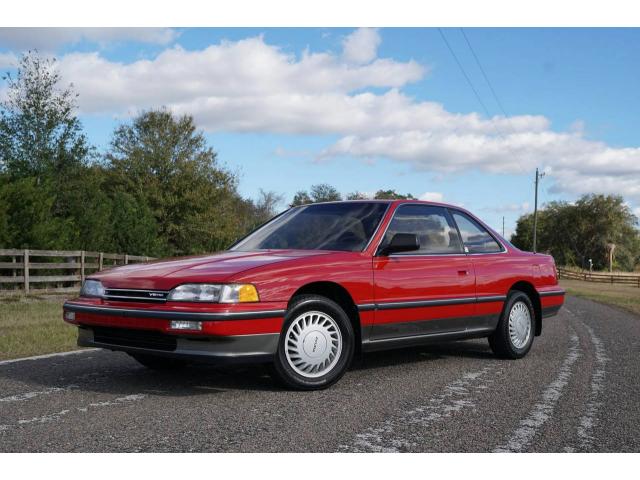1986 Acura Legend Coupe
- Brand: Acura
Honda introduced the model in Japan on October 22, 1985, to be their premier luxury model, and in North America for the 1986 model year, as the top of the line model for its then-new Acura lineup. Sedan models came to the market first, powered by a 151 hp (113 kW) 2.5 L C25A V6, with coupes making their first appearance in 1987, powered by a new 161 hp (120 kW) 2.7 L C27A engine. Sedans received the new engine for 1988.
The Legend was the first production Honda vehicle to offer a V6 engine. The 1987 Acura Legend LS coupe would be the first Japanese car to offer a driver's side airbag. The Legend was a result of a joint venture with Britain's Austin Rover Group called Project XX that started in November 1981 with the Austin Rover-Honda XX letter of intent signed by the two companies to replace the Rover SD1 and to provide a luxury vehicle for Honda. The Rover Company had a long established reputation as a luxury car in the United Kingdom and Europe, demonstrated with the Rover P6, and Honda wanted to introduce a luxury car for both domestic Japanese and the United States markets. The joint development produced the Legend and the corresponding British version was the Rover 800-series, which was badged under the Sterling brand in the United States and competed with the Legend.
Rover also wanted to return to the American market when they had reportedly sold only 1,500 cars in 1971, and a brief return in 1980, selling 800 Rover SD1s by offering the Sterling.
The Legend won Car and Driver's Ten Best three years in a row and Motor Trend's Import Car of the Year for 1987. Manual-equipped models could accelerate from 0-60 mph (97 km/h) in under 8 seconds and reach a top speed of 135 mph (217 km/h). Sedan models had a drag coefficient of 0.32, while coupes were only 0.30.
When the Legend was introduced, Honda's newly established luxury car division just for the Legend was called Acura, using the advertising slogan "Precision Crafted Performance", and the Legend was offered with one factory installed option, the choice of transmission used, and one trim level. In the 1986 sales brochure, the Legend's full name used was "Legend Touring Sedan". The vehicle was virtually identical in luxury content to the Japanese market V6Zi, but was identical in size and the longer overall length of the top level V6Xi to comply with United States crash standards, using the larger 2.5 V6 engine. The Technics supplied 80W four speaker cassette tape stereo offered four user programmable equalizer settings, and was equipped with a dual diversity antenna, meaning it had a conventional extendable power antenna and an embedded antenna in the rear window. One of the novelty items was a simple volume control rocker switch and a pre-set radio station channel selector installed on the instrument binnacle within reach of the right hand; the opposite side of the instrument binnacle had a button to open, tilt or close the standard equipped glass moonroof with sun shade.
The North American Legend was not offered with some of the items offered in Japan, such as automatic, one-touch climate control, and 100% wool cloth interior in brown. Blue interior was shared with Japan and North America, but brown was not offered in North America, and "sand gray" was offered instead. Exterior colors were matched to only one interior color choice and leather was not offered. Due to the success Honda had with the Legend, it served as an inspiration for the Subaru Legacy with which it shares many visual resemblances and dimensions both inside and out.
In late 1988 for the 1989 model year, the sedan received some minor tweaks, upgrading to the one-piece front headlamps already in use in Japan since the 1985 introduction, a revised front bumper, trunk lid, tail light cluster, and an upgraded double-wishbone rear suspension, with a new alloy wheel appearance. By that time all Legends came equipped with a Honda-designed 4-wheel anti-lock brake system. A driver's side airbag was now standard on all Legends. Other features such as power driver's seat memory for 3 positions were added. High-end LS models featured a trip computer, electronic vehicle monitoring system in the center console and a Bose sound system. It was also joined by the Acura Vigor which set the stage for the larger second generation Legend introduced October 1990.
For the 1990 model year, all Legends came with body-colored side mirrors. Legend coupes had a revised body-colored front grille, new red & clear tail lights, and improved front seats. LS model coupes also received a trunk-mounted lip spoiler. All LS models featured burlwood interior trim. Production of the first-generation models ended in 1990 as a second-generation version became available for the 1991 model year. At least by the 1990 model year, the fuel filler door on the sedan had been moved rearward about 15 cm (5.9 in).
From the exterior, there are only superficial similarities between the Legend and its Rover 800/Sterling cousin. Both cars share the 2.5L and 2.7L Honda engine with 160 hp (119 kW) and a 4-speed automatic transmission. The core structure and chassis design is also common to both cars, however the Rover version has its own exterior panelwork, interior and electrical systems. The Rover was also offered with a 2.0L in-line 4-cylinder engines, however the Legend was only available with V6 power regardless of market. In Japan only, Honda installed a turbocharger with variable geometry in the Legend with the smaller 2.0 L V6, called the "Wing Turbo" for model year 1989.
Source: Wikipedia & bringatrailer
| Specification | |
| Production Start | 1986 |
| Production End | 1990 |
| Country of origin | USA |



































